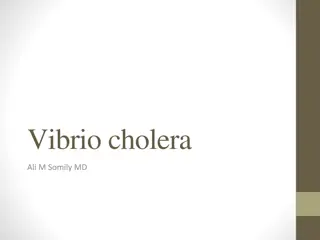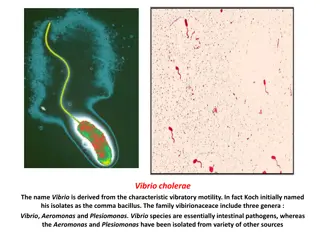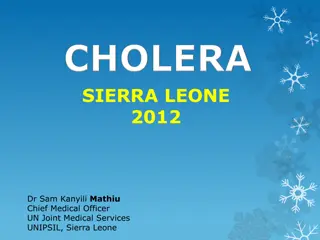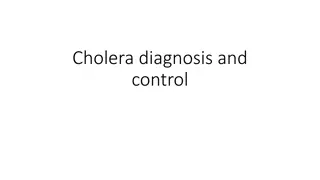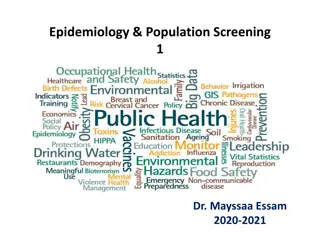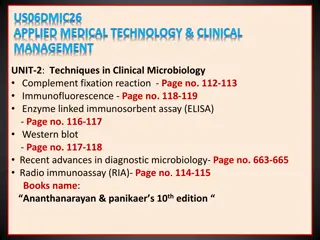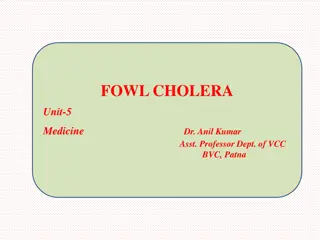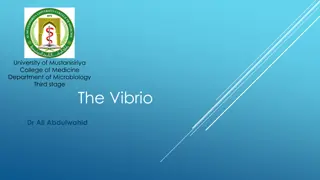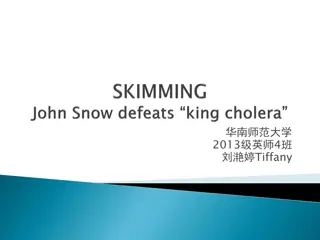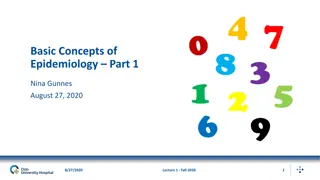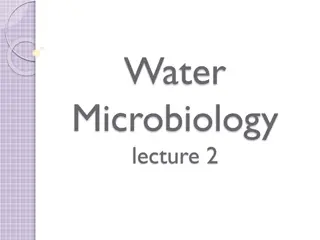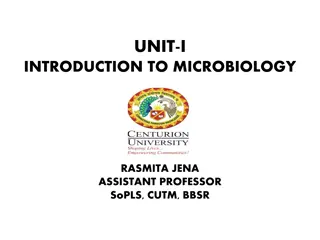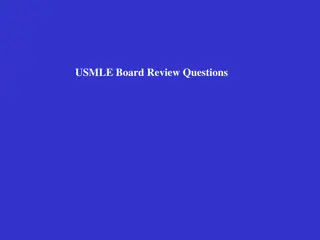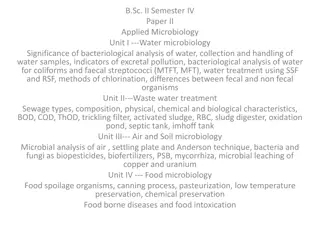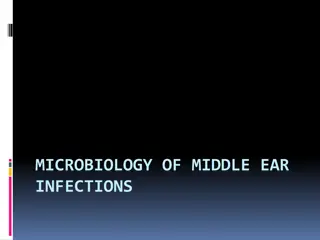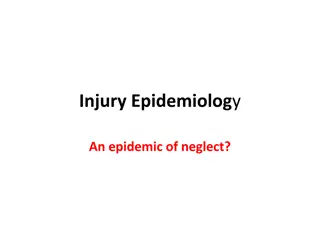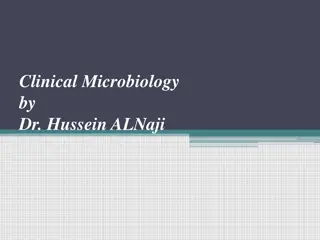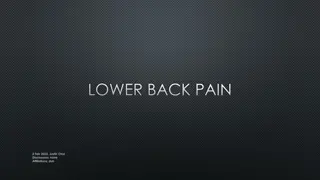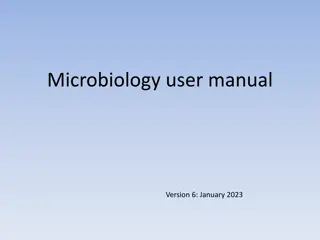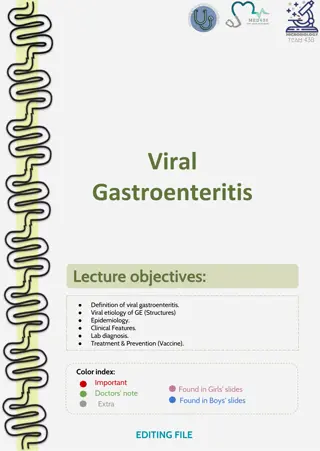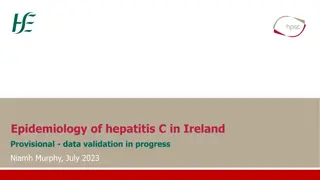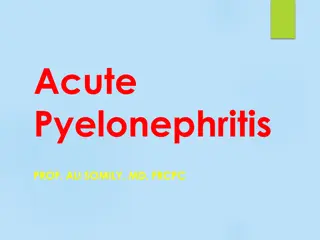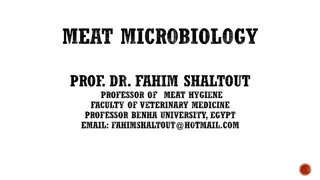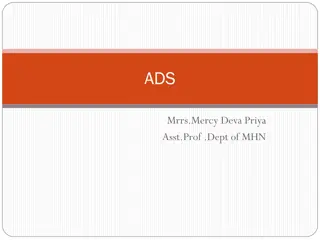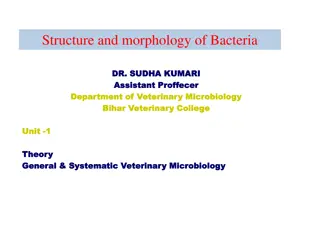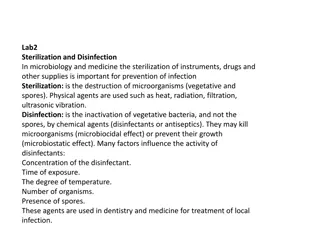Understanding Cholera: Epidemiology, Microbiology, and Clinical Features
Cholera is a life-threatening intestinal infection caused by Vibrio cholera bacteria. The disease is water-borne and prevalent in regions with poor sanitation. Learn about the epidemiology, microbiological characteristics, pathogenesis, clinical features, and management of cholera from this comprehensive lecture.
Download Presentation

Please find below an Image/Link to download the presentation.
The content on the website is provided AS IS for your information and personal use only. It may not be sold, licensed, or shared on other websites without obtaining consent from the author. Download presentation by click this link. If you encounter any issues during the download, it is possible that the publisher has removed the file from their server.
E N D
Presentation Transcript
LECTURE: Vibrio cholera Editing File + Important Doctor s notes Extra explanation Only F or only M " " .
OBJECTIVES: Know the epidemiology of cholera and history of cholera Know the microbiological characteristic of cholera Describe the pathogeneses of cholera Describe the clinical features of cholera Describe the methods for laboratory diagnosis Know the management of cholera and control of outbreak
Vibrio cholera Vibrio cholera Overview Cholera is a life-threatening intestinal infection (small intestine) that causes severe secretory diarrhea. Caused by vibrio cholera which is a comma- shaped gram-negative rods. Produce a non-invasive enterotoxin (a non-invasive diarrheal disease) which leads to outbreak and epidemic. It is a Water-borne illness caused by ingesting of water/food, Grows in salt and fresh water.( during war ,hurricanes,etc) Discovery John Snow discovered an outbreak in London 1854 It was related to broad street pump sewage contamination. Removal of the pump handle end of the outbreak. , Epidemiology V. cholera O1 ( till now) and O139 ( in asia only ) serogroup1 organisms are the causes of epidemic cholera. Seven major outbreaks. Each year 3-5 millions cases result in 100,000 deaths. A major epidemic disease. Common in India, Sub-Saharan Africa & Southern Asia but Very rare in industrialized countries. It is a leading cause of death in Africa. Endemic in areas of poor sanitation (India and Bangladesh)(Endemic in > 50 countries). In 2016 in Haiti after Hurricane Matthew, in South Soudan and Yemen and many other African countries Risk factors People with low gastric acid are more susceptible (Children and Elderly). O blood type (O>> B > A > AB). ( only O1+O139cause cholerae and the only serotype produce toxin) 1O1 Serotype are divided into 2 types: 1)classic 2) El-tor . O139 Serotype : can cause outbreak
Transmission Transmitted by fecal-oral route (Strictly Human transmitted) Resulting diarrhea makes it easy for bacteria to spread in unsanitary conditions causing epidemics. Common in summer grows in brackish estuaries and coastal seawaters, often in close association with copepods or other zooplankton. Sewage or infected person contaminate water supply. Undercooked-shellfish. Children, elderly and people with less gastric acidity are at higher risk then others. Infectivity Period of infectivity during acute stage till recovery ( end one to three wks) Infected person can produce up to 20 L of 109 CFU/ml /day Has high infectious dose NOT like Shigella Infectious dose 106-1011 colony-forming units Due to harsh environment of the intestine i.e. temperature and stomach acidity and Bile salts, organic acids in the intestine Pathogenesis: Vibrio cholerae uses toxin-coregulated pili (TCP) to colonize the human intestine. Produce Enterotoxin THEN THIS WILL ACTIVATES cAMP then it will affects chloride channels and then this chloride goes to lumen then sodium follow chloride creating an osmotic gradient so water goes and secretes a large amount of watery diarrhea.
Clinical manifestation: Incubation period: Ranges from a few hours to 5 days (range 1-3 days). Depending on gastric acidity and initial infectious dose 75% are asymptomatic Mild disease (20%) Severe symptoms (2-5% ) Cholera Gravis Vomiting Cramps Watery diarrhea (1 L/hour), consisting of: flecks of white mucus (rice water stool) with a fishy odor Rapid loss of body fluids(6L/H) hypovolemic shock(Severe metabolic acidosis due to inadequate O) and electrolytes imbalance( Ca ++ and K can lead to ileus, muscle pain and spasm, and even tetany) multi organ failure (Cardiac and renal). Sunken eyes , and skin turgor ( tenting) , cold and clammy . Anuric and lactic acidosis ( Kussmual breathing ). Hypoglycemia leads to seizure or comma. Cardiac and Renal failure. Aspiration pneumonia (from vomiting). Prognosis Mortality 50-60% without treatment within 12 hours or less Mortality <1% with rehydration Without treatment, death in 18 hours-several days.
Diagnosis Suspect in sever diarrhea with dehydration. Other non-invasive bacterial, ETEC and viral gastroenteritis might have similar presentation. Complete history and physical examination. Insert central line for IV fluid, collect blood for basic routine tests ( chemistry and hematology). Send stool for smear and culture on special media. Culture not routinely performed, you have to request it. Dark field microscopy (shooting stars) Gram stain (curve Gram Negative bacilli) Culture on thiosulfate citrate bile sucrose (TCBS) agar-yellow colonies Recovery of organisms can be enhanced by enrichment of stool in alkaline peptone water. (60-100%)
Microbiology Microbiology Vibrio cholera is highly motile, gram-negative rods . curved or comma-shaped rods with a single polar flagellum. Biotype O 1 antigen Serotype Antigen O 139 serogroup appeared in Bangladesh 1992 Classical Ogawa A,B Has poly saccharide capsule but does not have O1 antigen Inaba A,C Hikojima A,B,C El Tor Ogawa A,B Inaba A,C Hikojima A,B,C Non-O1, Non-O139 Serogroup Most are CT (cholera toxin) negative and are not associated with epidemic disease.
Treatment Antibiotics Basically rehydration and antimicrobial therapy. Rehydration should be started immediately before confirming the diagnosis. Either oral rehydration if the patient can tolerate it ( not vomiting or start IV rehydration. Decrease mortality from 50% to 1 %. Give 1.5 time the amount lost. Start when 10% of total body weight lost. Patients recovered within 3-6 days. Oral Rehydration Salt (ORS) by WHO and UNICEF ( in mild cases ) One pack in 1 liter contain NaCl, KCl, NaHCO3, glucose IV use either Ringer s lactate, Saline or Sugar and water Reduce the recovery time to 2-3 days. Decrease infectivity. Azithromycin single-dose is often the preferred therapy especially in children. Or Ciprofloxacin Or Tetracycline, Doxycycline Can be a bioterrorism agents Ease of procurement Simplicity of production in large quantities at minimal expense Ease of dissemination with low technology Silent dissemination
International Efforts WHO: Global Task Force on Cholera Control Prevention Not important Wash your hand frequently Boil water and chlorination. Cook all types of food very well. Avoid salad, ice and iced food Reduce mortality and morbidity Provide aid for social and economic consequences of Cholera CDC U.N.: GEMS/Water Water Sanitation Water treatment Disrupt fecal-oral transmission if present Global Water Quality Monitoring Project Addresses global issues of water quality with monitoring stations on all continents Killed Whole-cell Vaccines Live Attenuated Vaccines Adult 50% protection for 6 months 60% protection for 2 years children aged 2-5 < 25% protection protection rapidly declines after 6 months Doses Multiple doses 3 doses Side effects -------------------- Mild diarrhea, abdominal cramping
SUMMARY: It is a Water-borne illness caused by ingesting of water/food. ( during war , hurricanes , etc ) Has high infectious dose NOT like Shigella Infectious dose 106-1011 colony-forming units Symptoms : vomiting , cramps , diarrhea ( rice water stool ) Culture on thiosulfate citrate bile sucrose (TCBS) agar-yellow colonies Treatment : Basically rehydration and antimicrobial therapy. Antibiotics : Azithromycin single-dose is often the preferred therapy especially in children Or Ciprofloxacin Or Tetracycline, Doxycycline Prevention : sanitation Cholera is a life-threatening intestinal infection that causes severe secretory diarrhea. Caused by vibrio cholera which is a comma- shaped gram-negative rods. Produce a non-invasive enterotoxin (a non-invasive diarrheal disease) which leads to outbreak and epidemic.
QUIZ: 1.Which of the following is NOT correct about cholera? A)Gram ve bacilli B)Oxidase +ve and urease ve C)Has a single polar flagellum D) not invasive 2.Which of the following media is used to confirm diagnosis of cholera? A)TCBS agar B)Blood agar C)LJ agar D)Chocolate agar 3.What is the time for incubation: A)1-3 days B) 2-5 days C) 3-8 days D) 18 hours several hours Answers : 1-B , 2-A , 3-A
THANK YOU FOR CHECKING OUR WORK, BEST OF LUCK! Hamad alkhudhairy Saud Alshenaifi Yousef Aljebrin Shrooq Alsomali Heba Alnasser Ohoud Abdullah Doctors slides



